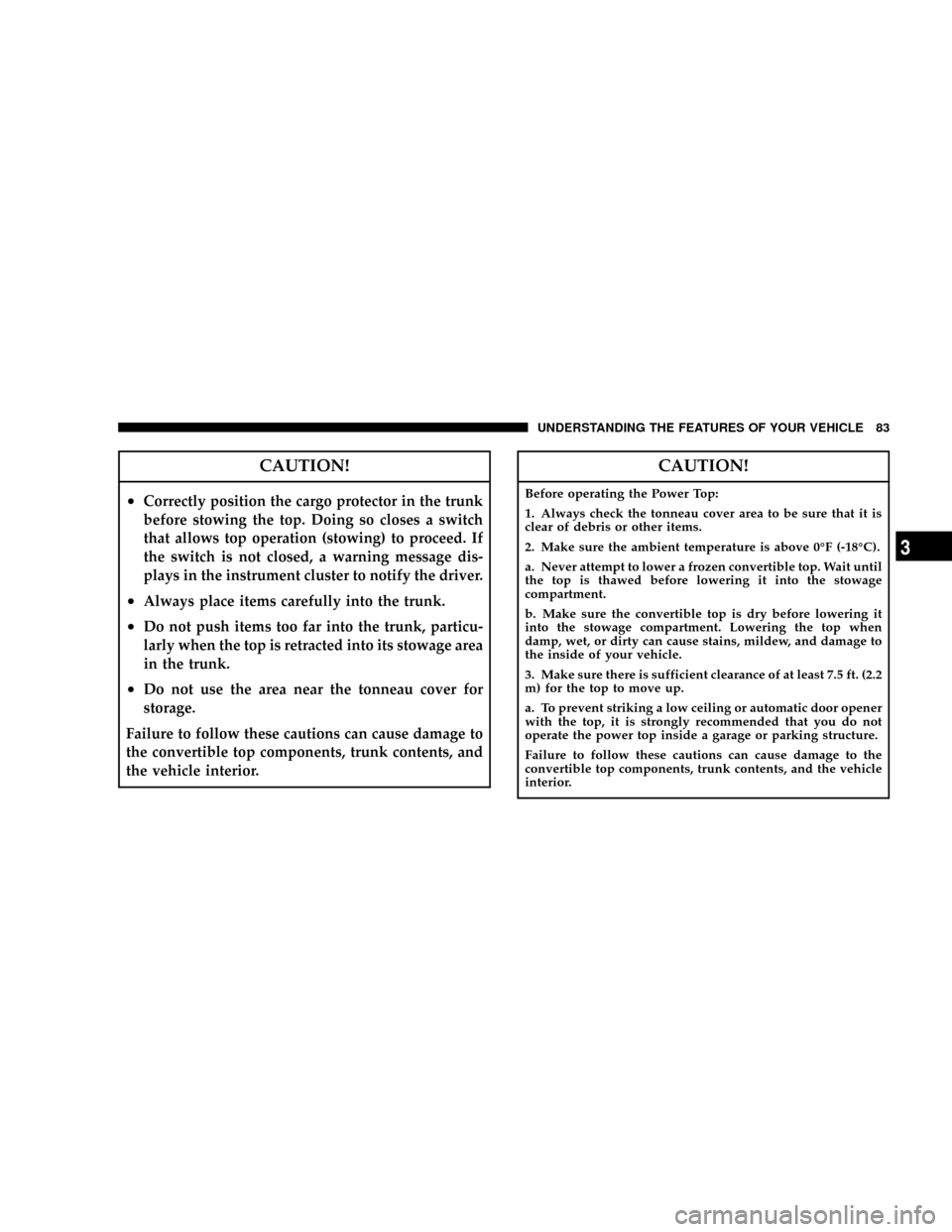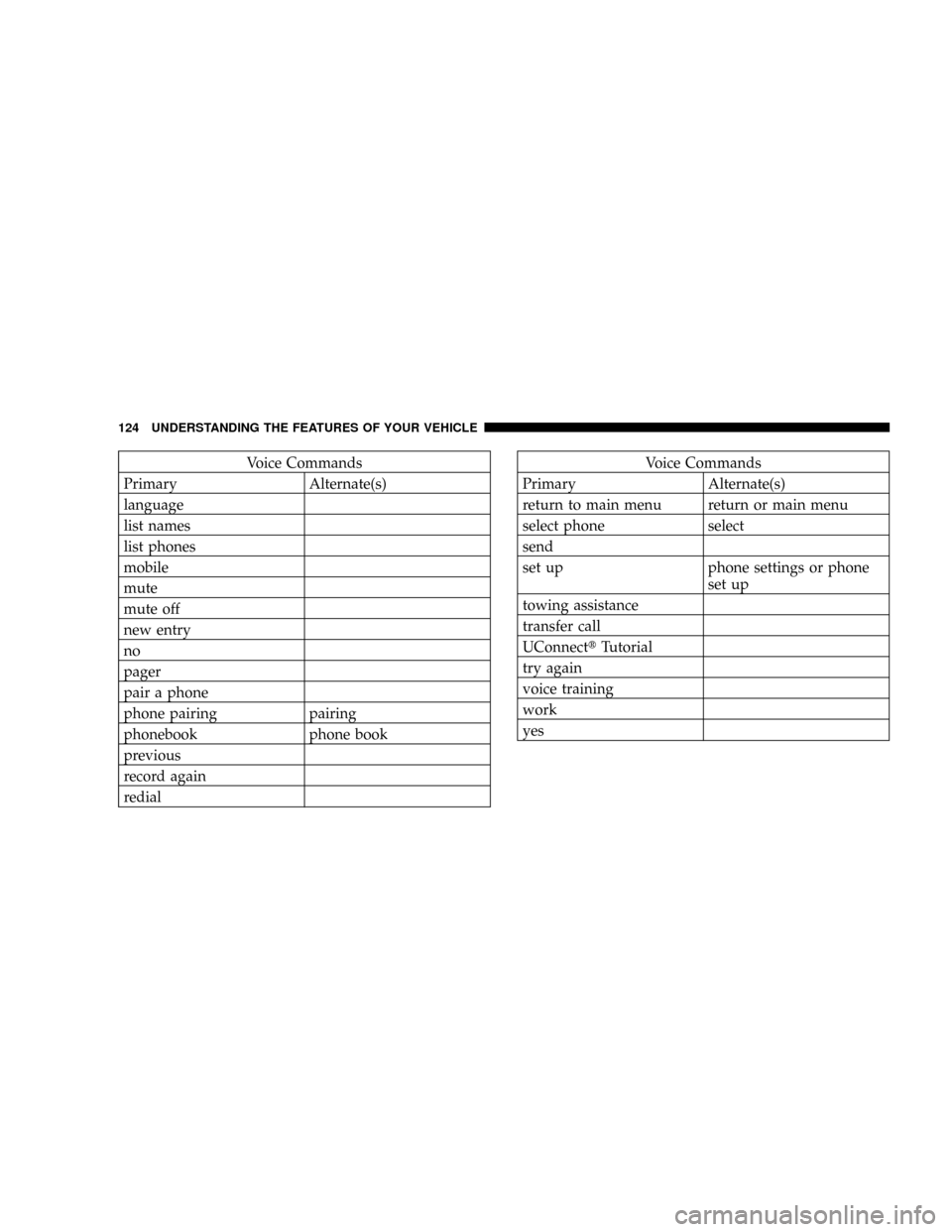towing CHRYSLER SEBRING CONVERTIBLE 2008 3.G Owners Manual
[x] Cancel search | Manufacturer: CHRYSLER, Model Year: 2008, Model line: SEBRING CONVERTIBLE, Model: CHRYSLER SEBRING CONVERTIBLE 2008 3.GPages: 454, PDF Size: 5.8 MB
Page 83 of 454

CAUTION!
²Correctly position the cargo protector in the trunk
before stowing the top. Doing so closes a switch
that allows top operation (stowing) to proceed. If
the switch is not closed, a warning message dis-
plays in the instrument cluster to notify the driver.
²Always place items carefully into the trunk.
²Do not push items too far into the trunk, particu-
larly when the top is retracted into its stowage area
in the trunk.
²Do not use the area near the tonneau cover for
storage.
Failure to follow these cautions can cause damage to
the convertible top components, trunk contents, and
the vehicle interior.
CAUTION!
Before operating the Power Top:
1. Always check the tonneau cover area to be sure that it is
clear of debris or other items.
2. Make sure the ambient temperature is above 0ÉF (-18ÉC).
a. Never attempt to lower a frozen convertible top. Wait until
the top is thawed before lowering it into the stowage
compartment.
b. Make sure the convertible top is dry before lowering it
into the stowage compartment. Lowering the top when
damp, wet, or dirty can cause stains, mildew, and damage to
the inside of your vehicle.
3. Make sure there is sufficient clearance of at least 7.5 ft. (2.2
m) for the top to move up.
a. To prevent striking a low ceiling or automatic door opener
with the top, it is strongly recommended that you do not
operate the power top inside a garage or parking structure.
Failure to follow these cautions can cause damage to the
convertible top components, trunk contents, and the vehicle
interior.
UNDERSTANDING THE FEATURES OF YOUR VEHICLE 83
3
Page 112 of 454

Your phone must be turned on and paired to the
UConnecttsystem to allow use of this vehicle feature in
emergency situations, when the cell phone has network
coverage and stays paired to the UConnecttsystem.
Towing Assistance
If you need towing assistance:
²Press the PHONE button to begin.
²After the9Ready9prompt and the following beep, say
9Towing Assistance.9
NOTE:The Towing Assistance number dialed is based
on the country where the vehicle is purchased (1-800-528-
2069 for the United States of America, 1-877-213-4525 for
Canada, 55-14-3454 for Mexico City and 1-800-712-3040
for outside Mexico City in Mexico).
Please refer to the 24-Hour ªTowing Assistanceº cover-
age details in the Warranty information booklet and on
the 24±Hour Towing Assistance Card.
Paging
To learn how to page, refer to9Working with Automated
Systems.9Paging works properly except for pagers of
certain companies, which time out a little too soon to
work properly with the UConnecttsystem.
Voice Mail Calling
To learn how to access your voice mail, refer to9Working
with Automated Systems.9
Working with Automated Systems
This method is used in instances where one generally has
to press numbers on the cellular phone keypad while
navigating through an automated telephone system.
You can use your UConnecttsystem to access a voice
mail system or an automated service, such as a paging
service or automated customer service line. Some ser-
vices require immediate response selection. In some
instances that may be too quick for use of the UConnectt
system.
112 UNDERSTANDING THE FEATURES OF YOUR VEHICLE
Page 124 of 454

Voice Commands
Primary Alternate(s)
language
list names
list phones
mobile
mute
mute off
new entry
no
pager
pair a phone
phone pairing pairing
phonebook phone book
previous
record again
redialVoice Commands
Primary Alternate(s)
return to main menu return or main menu
select phone select
send
set up phone settings or phone
set up
towing assistance
transfer call
UConnecttTutorial
try again
voice training
work
yes
124 UNDERSTANDING THE FEATURES OF YOUR VEHICLE
Page 176 of 454

INSTRUMENT CLUSTER DESCRIPTIONS
1. Fuel Gauge
When the ignition switch is in the ON position, the
pointer will show the level of fuel remaining in the
fuel tank.
2. Fuel Door Reminder
This is a reminder that the Fuel Filler Door is
located on the left side of the vehicle.
3. Temperature Gauge
The temperature gauge shows engine coolant tem-
perature. Any reading below the red area of the
gauge shows that the engine cooling system is
operating properly. The gauge pointer may show a
higher than normal temperature when driving in hot
weather, up mountain grades, in heavy stop and go
traffic, or when towing a trailer.If the pointer rises to theH(red) mark, the instrument
cluster will sound a chime. Pull over and stop the vehicle.
Idle the vehicle with the air conditioner turned off until
the pointer drops back into the normal range. If the
pointer remains on theH(red) mark, turn the engine off
immediately and call for service.
There are steps that you can take to slow down an
impending overheat condition. If your air conditioning is
on, turn it off. The air conditioning system adds heat to
the engine cooling system and turning off the A/C
removes this heat. You can also turn the Temperature
control to maximum heat, the Mode control to Floor and
the Fan control to High. This allows the heater core to act
as a supplement to the radiator and aids in removing heat
from the engine cooling system.
4. Speedometer
Indicates vehicle speed.
176 UNDERSTANDING YOUR INSTRUMENT PANEL
Page 181 of 454

Dual Trip Odometer Ð If Equipped
Press and release this button to change the display from
odometer to ªTrip A.º Press and release it a second time
to change the display to ªTrip B.º Press and release it a
third time to change the display back to the odometer.
To reset the trip odometer, first display the trip mileage
that you want to reset, ªTrip Aº or ªTrip B.º Then push
and hold the button (approximately 2 seconds) until the
display resets to 0. The odometer must be in Trip Mode to
reset the trip odometer.
17. Electronic Throttle Control Indicator Light
This red illuminated light informs you of a
problem with the Electronic Throttle Control
system. If a problem is detected, the light will
come on while the engine is running. If the
light remains lit with the engine running your vehicle
will usually be drivable and not need towing, however
see your dealer for service as soon as possible.If the light is flashing when the engine is running you
may experience power loss, an elevated/rough idle, and
increased brake pedal effort, and your vehicle may
require towing. Immediate service is required.
The light will come on when the ignition switch is first
turned on and remain on briefly as a bulb check. This is
normal. If the light does not come on during starting,
have the system checked by an authorized dealer.
18. Electronic Stability Program (ESP) Indicator
Light/Traction Control System (TCS) Indicator Light Ð
If Equipped
If this indicator light flashes during accelera-
tion, apply as little throttle as possible. While
driving, ease up on the accelerator. Adapt your
speed and driving to the prevailing road con-
ditions, and do not switch off the ESP, or TCS Ð if
equipped.
UNDERSTANDING YOUR INSTRUMENT PANEL 181
4
Page 186 of 454

(Refer to ªTire Inflation Pressuresº under ªTires Ð Gen-
eral Informationº and to ªTire Pressure Monitor System
(TPMS)º in Section 5 of this manual for more informa-
tion).
25. Malfunction Indicator Light
This light is part of an onboard diagnostic system
called OBD that monitors emissions, engine, and
automatic transaxle control systems. The light
will illuminate when the key is in the ON/RUN position
before engine start. If the bulb does not come on when
turning the key from LOCK/OFF to ON/RUN, have the
condition checked promptly.
Certain conditions such as a loose or missing gas cap,
poor fuel quality, etc. may illuminate the light after
engine start. The vehicle should be serviced if the light
stays on through several of your typical driving cycles. In
most situations the vehicle will drive normally and will
not require towing.If the Malfunction Indicator Light flashes when the
engine is running, serious conditions may exist that
could lead to immediate loss of power or severe catalytic
converter damage. The vehicle should be serviced as
soon as possible if this occurs.
26. High Beam Indicator
This light shows that the headlights are on high
beam. Push the turn signal lever away from the
steering wheel to switch the headlights from high or low
beam.
27. Electronic Vehicle Information Center (EVIC)
DisplayÐPremium Cluster Only
This display shows the EVIC messages when the appro-
priate conditions exist. Refer to ªElectronic Vehicle Infor-
mation Center (EVIC)º in this section for more informa-
tion.
186 UNDERSTANDING YOUR INSTRUMENT PANEL
Page 250 of 454

NStarting............................315
NCruising Range.......................315
NReplacement Parts.....................315
NMaintenance.........................315
mAdding Fuel..........................316
NFuel Filler Cap (Gas Cap)...............316
NLoose Fuel Filler Cap Message............318
mVehicle Loading........................319
NVehicle Certification Label...............319
NGross Vehicle Weight Rating (GVWR).......319
NGross Axle Weight Rating (GAWR).........320
NOverloading.........................320NLoading............................321
mTrailer Towing.........................322
NCommon Towing Definitions.............322
NTrailer Hitch Classification...............324
NTrailer Towing Weights
(Maximum Trailer Weight Ratings).........325
NTrailer And Tongue Weight..............326
NTowing Requirements..................327
NTowing Tips.........................331
mRecreational Towing (Behind Motorhome, Etc.) . . 333
NTowing This Vehicle Behind Another Vehicle
(Flat Towing With All Four Wheels On The
Ground)............................333
250 STARTING AND OPERATING
Page 260 of 454

DRIVE (OVERDRIVE) With 6±Speed Transaxle
This range should be used for most city and highway
driving. It provides the smoothest upshifts, downshifts,
and best fuel economy. However, use the AutoStickt
mode and select the[5]range when frequent transaxle
shifting occurs while using the DRIVE range, such as
when operating the vehicle under heavy loading condi-
tions, (i.e. in hilly terrain, traveling into strong head
winds or while towing heavy trailers). Under these
conditions, using the[5]range will improve performance
and extend transaxle life by reducing excessive shifting
and heat build-up.
DRIVE (OVERDRIVE) With 4±Speed Transaxle
This range should be used for most city and highway
driving. It provides the smoothest upshifts, downshifts,
and best fuel economy. However, select the[3]range
when frequent transaxle shifting occurs while using the
DRIVE (OVERDRIVE) range, such as when operating the
vehicle under heavy loading conditions, (i.e. in hillyterrain, traveling into strong head winds or while towing
heavy trailers). Under these conditions, using the[3]
range will improve performance and extend transaxle life
by reducing excessive shifting and heat build-up.
[3](DRIVE) With 4±Speed Transaxle
This range eliminates shifts into DRIVE (OVERDRIVE).
The transaxle will operate normally in First, Second, and
Third while in this range. The[3](DRIVE) range should
also be used when descending steep grades to prevent
brake system distress.
NOTE:Using the [3] (DRIVE) range while operating the
vehicle under heavy operating conditions will improve
performance and extend transaxle life by reducing exces-
sive shifting and heat build up.
LOW With 4±Speed Transaxle
This range should be used for engine braking when
descending very steep grades. In this range, upshifts will
260 STARTING AND OPERATING
Page 262 of 454

NOTE:Even if the transaxle can be reset, it is recom-
mended that you visit a dealer at your earliest possible
convenience. Your dealer has diagnostic equipment to
determine if the problem could recur.
If the transaxle cannot be reset, dealer service is required.
AUTOSTICKTÐ IF EQUIPPED
AutoSticktis a driver-interactive transaxle that offers six
manual ratio changes to provide you with more control
of the vehicle. AutoSticktallows you to maximize engine
braking, eliminate undesirable upshifts and downshifts,
and improve overall vehicle performance. This system
can also provide you with more control during passing,
city driving, cold slippery conditions, mountain driving,
trailer towing, and many other situations.
AutoSticktSelector Lever
262 STARTING AND OPERATING
Page 285 of 454

Loading
The vehicle maximum load on the tire must not exceed
the load carrying capacity of the tire on your vehicle. You
will not exceed the tire's load carrying capacity if you
adhere to the loading conditions, tire size, and cold tire
inflation pressures specified on the Tire and Loading
Information placard and in the ªVehicle Loadingº section
of this manual.
NOTE:Under a maximum loaded vehicle condition,
gross axle weight ratings (GAWRs) for the front and rear
axles must not be exceeded. For further information on
GAWRs, vehicle loading, and trailer towing, refer to the
ªVehicle Loadingº section of this manual.
To determine the maximum loading conditions of your
vehicle, locate the statement ªThe combined weight ofoccupants and cargo should never exceed XXX kg or XXX
lbs.º on the Tire and Loading Information placard. The
combined weight of occupants, cargo/luggage and
trailer tongue weight (if applicable) should never exceed
the weight referenced here.
Steps for Determining Correct Load Limit
1. Locate the statement ªThe combined weight of occu-
pants and cargo should never exceed XXX poundsº on
your vehicle's placard.
2. Determine the combined weight of the driver and
passengers that will be riding in your vehicle.
3. Subtract the combined weight of the driver and pas-
sengers from XXX kilograms or XXX pounds.
STARTING AND OPERATING 285
5